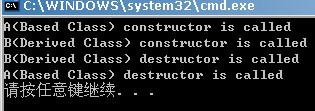基类和派生类的构造函数
来源:互联网 发布:印度军事实力知乎 编辑:程序博客网 时间:2024/04/30 04:42
关于基类和派生类的构造函数这篇文章写的很清楚,转载过来:
1. 顺序
当创建一个派生类的对象时,系统首先自动创建一个基类对象,也就是说,在调用派生类构造函数创建派生类对象之前,系统首先调用基类的构造函数创建基类对象。当派生类对象生命期结束时,首先调用派生类的析构函数,然后调用基类的析构函数。简而言之,就是说,构造函数:基类->派生类。析构函数:派生类->基类。
这个我们完全可以通过一个小程序来说明:
 //通过输出就可以看出在创建派生类对象b1时各个函数的调用顺序了
//通过输出就可以看出在创建派生类对象b1时各个函数的调用顺序了 #include <iostream>
#include <iostream> using namespace std;
using namespace std; class A
class A {
{ public:
public: A()
A() {
{ cout<<"A(Based Class) constructor is called"<<endl;
cout<<"A(Based Class) constructor is called"<<endl; }
} ~A()
~A() {
{ cout<<"A(Based Class) destructor is called"<<endl;
cout<<"A(Based Class) destructor is called"<<endl; }
} };
}; class B:public A
class B:public A {
{ public:
public: B()
B() {
{ cout<<"B(Derived Class) constructor is called"<<endl;
cout<<"B(Derived Class) constructor is called"<<endl; }
} ~B()
~B() {
{ cout<<"B(Derived Class) destructor is called"<<endl;
cout<<"B(Derived Class) destructor is called"<<endl; }
} };
};
 int main()
int main() {
{ B b1;
B b1; return 0;
return 0; }
}
OutPut:

2. 通过派生类的构造函数调用基类的构造函数有两种方式,隐式和显式两种。所谓隐式方式就是在派生类的构造函数中不指定对应的基类的构造函数,这个时候调用的是基类的默认构造函数(即含有默认参数值或不带参数的构造函数)。而所谓显式方式,就是在派生类的构造函数中指定要调用的基类的构造函数,并将派生类构造函数的部分参数值传递给基类构造函数。注:除非基类有默认的构造函数,否则必须采用显式调用方式。
下面分别给出一个隐式和显式调用的例子:
 #include <iostream>
#include <iostream> using namespace std;
using namespace std;
 class A
class A {
{ public:
public: A(int x = 0,int y = 0)
A(int x = 0,int y = 0) {
{ a = x;
a = x; b = y;
b = y; }
} private:
private: int a;
int a; int b;
int b; };
}; //基类A有默认的构造函数,可以隐式调用
//基类A有默认的构造函数,可以隐式调用 class B:public A
class B:public A {
{ public:
public: B(int z = 0)
B(int z = 0) {
{ c = z;
c = z; }
} private:
private: int c;
int c; };
};
 int main()
int main() {
{ B b1;
B b1; return 0;
return 0; }
}显式调用的例子:
 #include <iostream>
#include <iostream> using namespace std;
using namespace std;
 class A
class A {
{ public:
public: A(int x,int y)
A(int x,int y) {
{ a = x;
a = x; b = y;
b = y; }
} private:
private: int a;
int a; int b;
int b; };
}; //基类A没有默认的构造函数,其现有的构造函数需要传递参数,通过
//基类A没有默认的构造函数,其现有的构造函数需要传递参数,通过 //派生类构造函数调用A构造函数时必须如下显式调用
//派生类构造函数调用A构造函数时必须如下显式调用 class B:public A
class B:public A {
{ public:
public: B(int x,int y,int z):A(x,y)
B(int x,int y,int z):A(x,y) {
{ c = z;
c = z; }
} private:
private: int c;
int c; };
};
 int main()
int main() {
{ B b1(1,2,3);
B b1(1,2,3); return 0;
return 0; }
}
转载地址:http://www.cnblogs.com/krisdy/archive/2009/06/11/1501390.html
- 派生类的说明和构造函数
- 构造函数访问权限和基类构造函数,派生类的构造函数调用顺序
- 基类和派生类的构造函数
- c++基类和派生类的构造函数
- 派生类的构造函数
- 派生类的构造函数
- 派生类的构造函数
- 派生类的构造函数
- 派生类的构造函数
- 派生类的构造函数
- 派生类的构造函数
- 派生类的构造函数
- 派生类的构造函数
- 派生类的构造函数
- 派生类的构造函数
- 派生类的构造函数
- 派生类的构造函数
- 派生类的构造函数
- eclipse Installed JREs 配置引出的问题
- 线程中CreateEvent和SetEvent及WaitForSingleObject的用法
- 最近为.net2005 和SQL的链接搞昏头了。
- Java Obfuscator的原理
- 以后没有Everest了!。。。。
- 基类和派生类的构造函数
- 模拟发布 - 客户端Cookie 的研究
- 下载
- 为什么Google做不出Instagram?
- 一种很深的寄托
- Linux查看硬件信息及驱动设备
- jabberd相关
- Windows 2003如何打开RDP远程桌面(3389)
- 编辑框只能输入一个小数点


